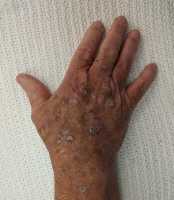
21 Sep Medicare Spends Hundreds of Millions Annually to Treat Precancerous Skin Lesions
MedicalResearch.com Interview with:
 Howa Yeung, MD
Howa Yeung, MD
Assistant Professor of Dermatology
Emory University School of Medicine
Atlanta, GA 30322
MedicalResearch.com: What is the background for this study? Would you briefly explain what is meant by actinic keratoses?
Response: Actinic keratoses are common precancerous skin lesions caused by sun exposure. Because actinic keratoses may develop into skin cancers such as squamous cell carcinoma and basal cell carcinoma, they are often treated by various destructive methods. We used Medicare Part B billing claims to estimate the number and cost of treated actinic keratoses from 2007 to 2015.
MedicalResearch.com: What are the main findings?
Response: While the number of Medicare Part B beneficiaries increased only moderately, the number of actinic keratoses treated by destruction rose from 29.7 million in 2007 to 35.6 million in 2015. Medicare paid an average annual amount of $413.1 million for actinic keratosis destruction from 2007 to 2015. Independently billing non-physician clinicians, including advanced practice registered nurses and physician assistants, are treating an increasing proportion of actinic keratosis, peaking at 13.5% in 2015.
MedicalResearch.com: What should readers take away from your report?
Response: Readers should understand that the burden of actinic keratosis treatment is increasing in the Medicare population. There is also an increasing proportion of actinic keratoses being treated by advanced practice registered nurses and physician assistants.
MedicalResearch.com: What recommendations do you have for future research as a result of this work?
Response: Further research is needed to determine which actinic keratoses are most likely to turn into skin cancer, so our prevention efforts are more targeted. Additionally, with advanced practice registered nurses and physician assistants treating a larger proportion of patients, we need to ensure patients benefit from this increased access while also maintaining diagnostic accuracy and quality treatments.
Disclosures: This study is supported in part by the Dermatology Foundation and the National Center for Advancing Translational Sciences of the National Institutes of Health under award numbers UL1TR002378 and KL2TR002381 (Dr Yeung) and the Harvey L. Neiman Health Policy Institute (Dr Duszak). No relevant conflict of interest was disclosed.
Citation:
[wysija_form id=”3″]
[last-modified]
The information on MedicalResearch.com is provided for educational purposes only, and is in no way intended to diagnose, cure, or treat any medical or other condition. Always seek the advice of your physician or other qualified health and ask your doctor any questions you may have regarding a medical condition. In addition to all other limitations and disclaimers in this agreement, service provider and its third party providers disclaim any liability or loss in connection with the content provided on this website.
Last Updated on September 21, 2018 by Marie Benz MD FAAD
